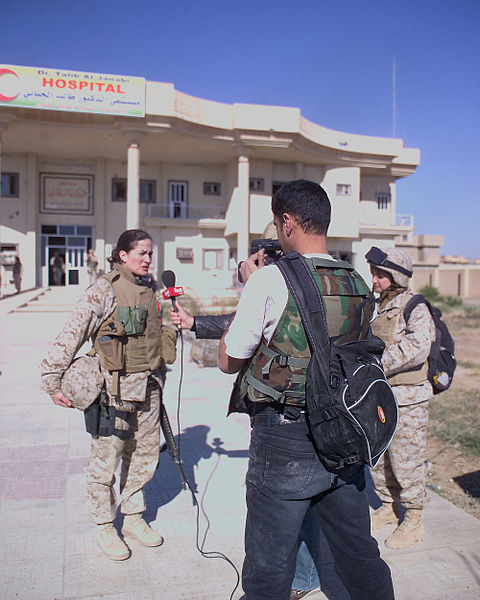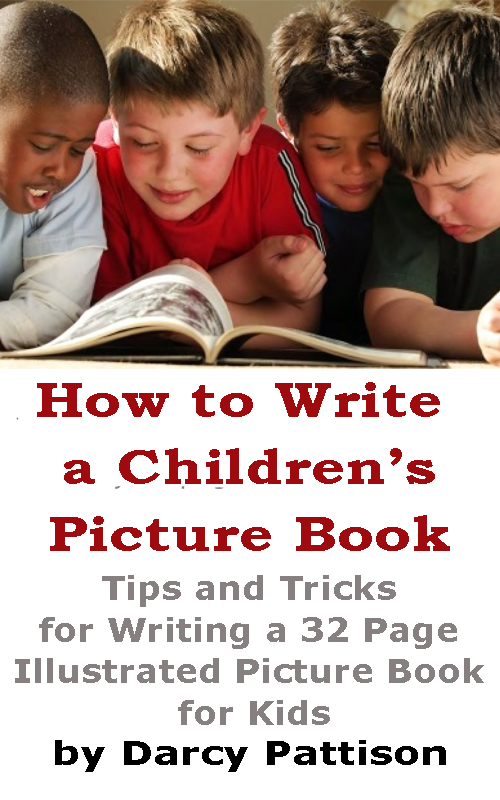As pleased and excited as I am, by Ashe Carters’ announcement, that women will be allowed in all military occupational specialties, I am also concerned that we do it right. Otherwise we may have public failures that cause people to question the decision.
The post Cautious optimism on “No Exceptions” with important caveats appeared first on OUPblog.
By Sandesh Sivakumaran
The last couple of years have been bad for journalists. I’m not referring to phone-hacking, payments to police, and the like, which have occupied much attention in the United Kingdom these last months. Rather, I’m referring to the number of journalists who have been killed in wartime.

Arab news reporters conduct an on-site interview with 4th Civil Affairs Group Public Affairs Officer Maj. M. Naomi Hawkins in front of the Dr. Talib Al-Janabi Hospital in Fallujah, Iraq, on Dec. 2, 2004. The hospital was one stop during a tour for media to different sites where reconstruction efforts are beginning after the November battle with insurgents. Photo by Cpl. Theresa M. Medina, U.S. Marine Corps.
These last two years alone have seen eminent journalists such as
Marie Colvin and
Tim Hetherington killed while reporting on armed conflicts. Just last month, two journalists were killed while reporting in
Syria. Deaths of journalists during conflicts are not new — Robert Capa and Gerda Taro both died while serving as war photographers. Increasingly, though, we are witnessing the targeting of journalists because they are journalists.
Why are journalists targeted?
Journalists play a critical role in wartime — reporting on events, revealing the horrors of war, investigating abuses by the parties. Their role is a particularly important one given the fog of war. It’s often through media reporting that the public takes notice of a situation and the international community is pushed into action. For these very reasons, journalists are not infrequently viewed as a thorn in the side of the government or the armed group. They may be considered unwanted witnesses to what is going on and targeted for their reporting.
How does the law of armed conflict protect journalists?
The law of armed conflict distinguishes between different types of journalists:
- Journalists who work for media outlets or information services of the armed forces.
- Journalists who accompany the armed forces and are authorized to do so, but who aren’t members of the armed forces, e.g., the embedded reporter.
- Journalists who are undertaking professional activities in areas affected by hostilities but who aren’t accompanying the armed forces, e.g., the broadcaster who is presenting from a conflict zone but who isn’t embedded with the troops.
The first category of journalists constitutes members of the armed forces. Accordingly, they don’t benefit from the protections afforded to civilians and their deaths don’t constitute a violation of the law.
The latter two categories of journalists are civilians. Accordingly, they can’t be attacked, unless and for such time as they take a direct part in hostilities. Reporting on events and investigating abuses committed by the parties can never constitute taking a direct part in hostilities, even if the investigations lead to greater support for one side or another.
Journalists may, however, prove to be casualties of lawful attacks. This is a particular risk for journalists who are embedded with troops. The law allows for the targeting of troops and that targeting may result in bystanders or embedded reporters becoming casualties. In order to judge the legality of such an attack, the law utilizes the principle of proportionality, ie we have to weigh up the expected loss of civilian life, injury to civilians, and damage to civilian objects with the concrete and direct military advantage anticipated. Only where the former is excessive when compared to the latter will the attack be unlawful. Although any loss of life is regrettable, the legal test means that deaths don’t necessarily imply that unlawful acts have been committed.
Particular controversies
One particularly controversial area of the law is the targeting of TV and radio stations. Civilian broadcasting services are protected from attack. They may be legitimate targets, however, if they constitute military objectives. In legal terms, this refers to objects that, “by their nature, location, purpose or use make an effective contribution to military action and whose total or partial destruction, capture or neutralization, in the circumstances ruling at the time, offers a definite military advantage.”
This would render dual purpose broadcasters that broadcast civilian programmes and which are used for military communications possible targets. Civilian broadcasters that broadcast propaganda are not generally considered military objectives, as propaganda doesn’t satisfy the test for a military objective. Thus, following NATO’s targeting of the RTS studio in Belgrade during the conflict in Kosovo, the Committee established by the Prosecutor of the International Criminal Tribunal for the former Yugoslavia to Review the NATO Bombing Campaign against the Federal Republic of Yugoslavia noted that, “if the attack on the RTS was justified by reference to its propaganda purpose alone, its legality might well be questioned by some experts in the field of international humanitarian law” (para. 76). Compare that to Radio Mille Collines, the broadcaster that was inciting genocide in Rwanda and which many people consider a legitimate target. The dividing line is a tricky one to draw.
Sandesh Sivakumaran is Associate Professor and Reader in International Law, University of Nottingham. He is the author of The Law of Non-International Armed Conflict (OUP, 2012), co-editor of International Human Rights Law (OUP, 2010) and recipient of the Journal of International Criminal Justice Giorgio La Pira Prize and the Antonio Cassese Prize. He advises and acts as expert for a range of states, inter-governmental organizations, and non-governmental organizations on issues of international law.
Subscribe to the OUPblog via email or RSS.
Subscribe to only law and politics articles on the OUPblog via email or RSS.
The post Killing journalists in wartime: a legal analysis appeared first on OUPblog.

National Veterans Awareness Week United States Senate Resolution 143 November 11 to November 17, 2012 The resolution calls for educational efforts directed at elementary and secondary school students concerning the contributions and sacrifices of veterans. Veterans Day “As we express our gratitude, we must never forget that the highest appreciation is not to utter words, but to [...]
Awkward Family Photos

11 Ways to Ruin a Photograph, written by Darcy Pattison.
Holidays mean family photos, right? This children’s book shows the extremes to which a kid can go to avoid those photos. The difference is that this girl has a good reason.
THE STORY: “11 Ways to Ruin a Photograph”
When her father goes soldiering for a year, a girl decides that without Dad at home, it’s not a family photo album. Though her beloved Nanny is in charge of the album that year, the girl makes sure that photographs of her never turn out well. It results in some awkward family photos! Photos are blurred, wind blows hair in her face. April rains bring umbrellas to hide behind. Halloween means a mask. This poignant, yet funny family story, expresses a child’s anger and grief for a Dad whose work takes him away for long periods of time. This story for kids is a tribute to the sacrifices made by military families and to those who care for children when a family needs support.
THIS STORY IS A WINNER!
In conjunction with “
The Help” movie (www.thehelpmovie.com),
TakePart.com (www.takepart.com/thehelp) recently sponsored three writing contests: a recipe contest, an inspirational story contest and a children’s story contest.
TakePart is the digital division of Participant Media which aims to bolster a movie’s audience with a message of social change. THE HELP movie campaign emphasized the role of stories in people’s lives. After winning the contest, the story was made into a children’s book.
Notice: This site and the story are not endorsed by or affiliated with TakePart, LLC or the motion picture “The Help” and or its distributors.
READ THE BOOK!
ORDER NOW:
THE AUTHOR: Darcy Pattison

Author Darcy Pattison
More on
Darcy Pattison
Resources, teacher’s guides and more.
 |
-

By: Maryann Yin,
on 7/25/2011
Blog: Galley Cat (Mediabistro)
( Login to Add to MyJacketFlap)
JacketFlap tags:
Middle East, military, service, Sandra Brown, Andrew Peterson, armed forces, James Rollins, David Morrell, Steve Berry, Mark Bowden, Kathy Reichs, USO, Clive Cussler, Andy Harp, Doug Preston, Operation Thriller, Authors, Add a tag
 This fall Clive Cussler, Sandra Brown, Kathy Reichs, Mark Bowden and Andrew Peterson will embark on Operation Thriller, a USO/Armed Forces Entertainment tour. This fall Clive Cussler, Sandra Brown, Kathy Reichs, Mark Bowden and Andrew Peterson will embark on Operation Thriller, a USO/Armed Forces Entertainment tour.
Operation Thriller sends authors to military bases around the world to entertain our troops–follow this link to read about last year’s tour. At the moment, the exact locations and tour dates cannot be revealed for security reasons. 2011 marks the 70-year anniversary of the USO organization.
Here’s more from the release: “OPERATION THRILLER, will fly to the Middle East, where they will sign autographs, pose for photos with the troops and talk about their books, movies, television series and writing. This trip marks the tour’s second installment, the first one kicked off in November 2010 and was comprised of Steve Berry, David Morrell, Doug Preston, James Rollins and Andy Harp.”
New Career Opportunities Daily: The best jobs in media.
|








 This fall Clive Cussler, Sandra Brown, Kathy Reichs, Mark Bowden and Andrew Peterson will embark on Operation Thriller, a USO/Armed Forces Entertainment tour.
This fall Clive Cussler, Sandra Brown, Kathy Reichs, Mark Bowden and Andrew Peterson will embark on Operation Thriller, a USO/Armed Forces Entertainment tour.